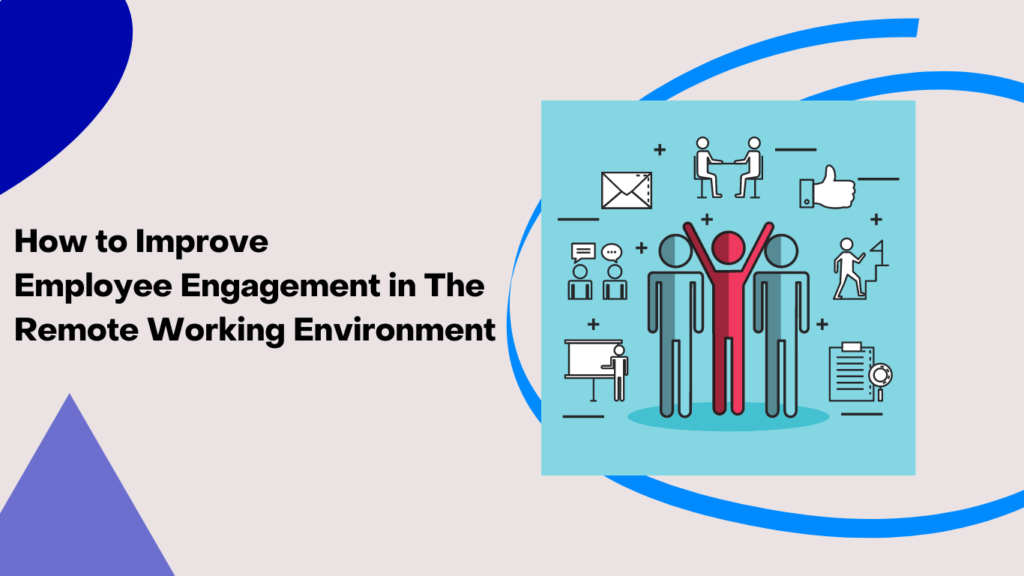How to Improve Employee Engagement in the Modern Remote Working Environment


Do you know that employee engagement is crucial to the success of any business, regardless of whether it operates out of a traditional office space or remotely?
In fact, according to Gallup’s “State of the American Workplace” report, engaged employees are more productive and profitable for their organizations.
So how can businesses improve employee engagement in the modern remote work environment? Check out our tips below!
Employee engagement in the modern workplace
Remote work is becoming more popular, as it offers many benefits to both the employee and the employer. However, employee engagement can be a challenge in this type of environment.
Thanks to technology, people can now work from anywhere at any time. While this change has its benefits, it also comes with its challenges.
One of the main challenges is employee engagement.
Employee engagement is the commitment and motivation that employees have to their job. Businesses need to keep employee engagement high, leading to higher productivity and lower employee turnover.
There are many ways businesses can improve employee engagement in the modern remote work environment.
Employee Engagement Improvement
Some of the ways of how businesses can improve employee engagement include:
- Providing employees with regular feedback
- Encouraging employees to take breaks
- Offering an employee development opportunities
- Creating a culture of trust and respect
- Provide the best working tools
- Allow employees for social interaction.
- Having a clear vision and mission for the company
By implementing these strategies, businesses can create a more productive and positive work environment for their employees.
Providing employees with regular feedback
Employees need regular feedback to stay engaged in their work. Feedback can be positive or negative reinforcement, some feedback for areas they need to improve.
Encouraging employees to take breaks
Employees also need time to relax and rejuvenate to stay engaged in their work. Taking breaks throughout the day is a good way to keep yourself from getting burned out.
Offering employee development opportunities
Employee development opportunities allow employees to learn new skills and grow their knowledge base. This can help them feel more engaged in their work.
Creating a culture of trust and respect

A culture of trust and respect is essential for employee engagement. Employees must feel acknowledged and valued.
Provide the best working tools
Make sure that employees have the tools they need to be successful. This includes everything from a good internet connection to the right software programs.
Create opportunities for social interaction. Just because employees are remote does not mean they do not crave social interaction.
Having a clear vision and mission for the company
Finally, businesses need to have a clear vision and mission for the company. This can help employees understand what the company is working towards and how it fits into the bigger picture.
Employee engagement in a remote workplace, what does it mean?

Employee engagement measures how connected employees feel to their work and how enthusiastic they are about their work.
Employee engagement is essential for two reasons:
- Engaged employees are more productive.
- Engaged employees are more likely to stay with an organization.
Employee engagement can be challenging to measure in a remote workplace because employees may not be physically present in the office.
Employees may not feel as connected to their work if they cannot see their coworkers or supervisor regularly.
Additionally, employees may not feel as enthusiastic about their work if they are working from home and have fewer opportunities for socialization.
How to create a culture of employee engagement in your remote team

Employee engagement is the level of employee involvement and commitment in their work. It contributes to employee productivity and motivation.
A remote work environment can be challenging to maintain employee engagement. There are a few ways to create a culture of improving employee engagement in your remote team:
- Have regular communication with your employees. This could include weekly video chats, emails, or chat messages.
- Make sure employees feel valued and appreciated. Offer perks such as remote working privileges, flexible hours, or paid time off.
- Encourage employees to take breaks and get up from their desks. This will help them stay focused and productive.
- Celebrate successes together as a team. This could include sharing highlights of the week or month or hosting a virtual happy
Strategies for staying connected with remote teams

With the growth of technology, more and more people are working remotely. This can be a challenge for businesses, as keeping employee engagement can be challenging.
However, businesses can use a few strategies to improve employee engagement in the modern remote work environment.
Create a policy for remote workers
This policy should include guidelines for communication and collaboration. It should also specify the expectations for productivity and how employees will be monitored.
Employees who use this software can be more productive. It is also a good tool for collaboration and communication and provides a sense of belonging to the organization.
Use technology to monitor employee productivity
You can track employee login times, activity levels, and website usage to determine who is working and who is not. By doing this, businesses can ensure that employees stay on task and meet their productivity goals.
By staying connected with their team and using technology to monitor productivity, businesses can ensure that employees are productive and engaged.
Tools and technologies keep employees engaged and productive

Find remote working tools to help keep employees connected and engaged in their work.
These tools can include anything from social media to communication tools to productivity tracking tools.
Tools that can help keep employees engaged and productive include:
Social media
Social media can help keep employees engaged and productive because it provides a way to connect with their work and each other.
It can also help employees feel more connected to the company and its goals. Additionally, social media can be an excellent way for employees to stay up-to-date on company news and events.
Communication tools
Employees are more engaged when they can communicate with each other and with their employer through tools such as mobile phones, tablets, and cloud-based applications.
Communication methods can also assist employees in feeling more attached to the firm and its objectives. Communication tools may also aid employees in keeping up with corporate developments and occurrences.
Get more out of your business
Get the best employee engagement content every week via mailing list
Productivity tracking tools
Employees are more likely to be productive if they can stay connected to their job and each other through tools that monitor their productivity.
Employees may be more inspired and engaged if they believe that their work positively impacts the company or the world. Employee engagement can also improve when employees feel a sense of belonging to the organization and its goals.
Productivity-tracking applications can help employers see where their employees are struggling or succeeding. You can use this information to help improve employee engagement in those areas.
The benefits of a highly engaged remote workforce

Employee engagement means that employees feel enthusiastic and committed to their work.
Employee engagement is a key predictor of organizational success, with research showing that companies with highly engaged employees outperform those with low employee engagement by 202%.
What are some examples of employee engagement?
Employee engagement can be defined as a positive, committed, and energized employee state characterized by feelings of involvement, satisfaction, and commitment to the organization and its goals.
Employee engagement can manifest itself in different ways, including but not limited to:
- Coming to work with a positive attitude
- Being highly motivated to do one’s best
- Being a team player
- Exhibiting high levels of productivity
- Exceeding people’s expectations
- Showing commitment to the organization’s goals
Employee engagement is essential for the success of an organization. Employee engagement leads to better employee performance, higher levels of customer satisfaction, and increased profitability.
Employee Engagement Model

The employee engagement model is a framework businesses can use to improve employee engagement in the modern remote work environment. The model has three key components: communication, recognition, and flexibility.
Communication is essential since it allows employees to feel part of their team and the organization.
Recognition is important because it makes employees feel appreciated and valuable.
Being flexible makes employees feel empowered and motivated.
When all three of these components are present, employee engagement will improve. When one or more of these components is missing, employee engagement will suffer.
The difference between employee engagement and employee experience?
Employee engagement is a measure of how satisfied and motivated employees are.
Employee experience, on the other hand, is made up of all the interactions that an employee has with their employer. This includes everything from recruitment to employee onboarding to retirement.
Employee engagement aims to create a positive work environment that encourages employees to be productive and motivated.
The goal of employee experience is to make sure that all interactions an employee has with their employer are positive and helpful.
Employee satisfaction and engagement
Employee satisfaction measures how happy an employee is with their job. On the other hand, engagement looks at how motivated and enthusiastic an employee is about their work.
Both employee satisfaction and employee engagement are essential for a company’s success.
What are the 12 elements of employee engagement?

Employee engagement is really about the employee’s level of involvement at work. It represents how hard an employee will work when they’re there (compared to how hard they might work if allowed to work from home).
Back in the day, employee engagement was all about being physically present at work and completing tasks.
But with the modern remote work environment, employee engagement has to be redefined.
Here are 12 elements of employee engagement in the modern remote work environment:
- Employee trust
Employee engagement starts with trust. If your employees don’t trust you, they’re not going to be engaged in their work.
Employees need to trust that you have their best interests at heart and that you’re not going to micromanage them or put them in a position where they’ll fail.
- Clear communication
You need to communicate your expectations clearly and give feedback regularly.
When employees feel like they’re in the dark, they’re less likely to be engaged in their work.
- Meaningful work
Employees need to feel like what they’re doing is important and impacts the company.
If they feel like their work is pointless, they’re not going to be engaged.
- Autonomy
Employees need to feel like they have some control over their work and that they’re not just robots who are completing tasks that someone else has assigned to them.
- Recognition
Employees need to feel appreciated. When they feel like their hard work is noticed and their contributions matter, they are more likely to be productive and happy.
When employees feel like their efforts are going unnoticed, they’re less likely to be engaged in their work.
- Growth potential
Employees need to feel like there’s room to grow and that their career isn’t stagnating.
When employees feel like they’re stuck in a dead-end job, they’re not going to be engaged.
- A positive work culture
Employees need to feel like they fit in with the company and share the same values.
When employees feel like they don’t belong, they’re less likely to be engaged.
- Supportive management
Employees need to feel like their managers are on their side and willing to help them grow professionally.
- Job satisfaction
Employees need to enjoy what they do and feel like their work has a purpose. When employees hate their job, they’re not going to be engaged.
- Flexibility
Employees need to feel like they can balance their work and personal lives without sacrificing one for the other.
When employees feel like they’re always working, they’re not engaged.
- Work/life balance
Employees need to take time off when they need it and not feel guilty about it. When employees are always working, they’re not going to be engaged.
Technology has helped people work anywhere and anytime and can still monitor their productivity by managers or bosses from a distance.
- Engagement tools
Using the right tools to engage employees, whether a messaging app, video conferencing software, or project management tool.
Sofi’s research found that if their employer offered financial wellness benefits, 48 percent of individuals would be more committed to staying with their organization for a longer period of time.
How does employee engagement drive growth?
Employee engagement is a critical factor in the organization’s success or failure.
Happy and engaged employees are more productive and likely to stick around, while disengaged workers can hurt morale and decrease productivity.
How does employee engagement impact productivity?
Employee engagement has a significant impact on employee productivity. When employees are fully engaged in their work, they are more focused and motivated to produce quality work.
Conversely, when employees are disengaged, they can be less productive and even harmful to the workplace dynamic employers can improve employee productivity by understanding the factors influencing employee engagement.
Signs of a disengaged employee

An employee who is not engaged may exhibit any or all of the following characteristics: lack of enthusiasm, poor work ethic, negative attitude, absenteeism.
There are many reasons why an employee may become disengaged. Still, some of the most common include a lack of communication or recognition from their manager, feeling undervalued or unchallenged in their role, and being overworked or stressed.
Is employee engagement sustainable?
Engagement is often defined as employee motivation. The level of employee engagement you want in your organization will depend on what’s important to you, the top management, and employees.
Many factors go into employee engagement. It’s not a one-size-fits-all model, and it changes over time.
Technology has helped people to work anywhere and anytime. They can be more productive because they’re not limited to working at their desks.
However, there is always the fear of being monitored and judged.
Achieving employee engagement can be about managing employee expectations. Still, it can also be about motivating people to get them involved and invested in the goals set for their team by providing the right tools and resources.
Businesses need to find a way to improve employee engagement in the modern remote work environment. It’s not always easy, but it’s worth it!
Are employee engagement surveys useful?
There is no one-size-fits-all answer to this question, as the usefulness of an employee engagement survey will vary depending on the specific business and its employees.
However, in general, employee engagement surveys can be a valuable tool for businesses to assess the overall engagement level of their employees and identify any areas that may need improvement.
When used correctly, employee engagement surveys can help businesses to improve employee engagement and, as a result, boost productivity and performance.
If you’re thinking of implementing employee engagement surveys in your business, make sure to consider the following tips:
- Define what employee engagement means to your business
- Choose the right survey platform
Are employee engagement surveys anonymous?
Yes, the employee engagement survey is anonymous. This helps to ensure that employees can provide honest feedback without fear of retribution. It also encourages employees to be more candid in their responses.
Conclusion
Employee engagement is critical to the success of any business. If businesses want their remote workers to be productive and efficient, they need to take employee engagement seriously. This means finding ways to keep employees interested and motivated.
Technology has made it possible for people to work from anywhere and anytime, which means employers have less control over their employees’ productivity.
However, there are still ways to measure employee engagement and ensure that employees are productive and happy.
Businesses should consider the following when trying to improve employee engagement in a remote work environment:
- Communication: Make sure employees feel connected to the company and their co-workers. Regular communication, both formal and informal, is critical.
- Purpose: Employees need to feel like their work is important and meaningful. Help them find ways to connect their work to the company’s goals.
- Autonomy: Give employees some control over their work within reason. Allow them to make choices and contribute their ideas.
Feedback: Employees need feedback not only on their work but also on their engagement. Feedback should be regular, timely, and specific.


